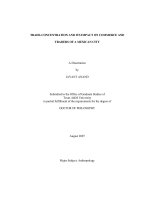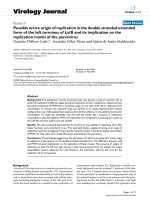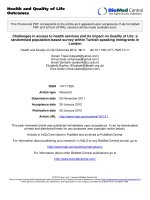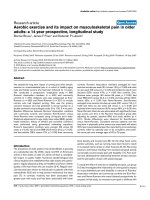The phenomenon of toobigtofail and its impact on the financial stability
Bạn đang xem bản rút gọn của tài liệu. Xem và tải ngay bản đầy đủ của tài liệu tại đây (622.54 KB, 2 trang )
Digest
World Bank Research
Volume 5 l Number 1 l Fall 2010
3
Too Big to Fail or Too Big to Save?
strong incentives to reduce their size
relative to the national economy.
Indeed, a smaller percentage of banks
were systemically important (relative
to GDP) in 2008 than in the two previous years (figure 1).
The problem of “too big to save”
facing systemically large banks in fiscally strapped countries is likely to
change the structure of the international banking system. Banks in all
financial systems will face pressure
to deleverage in order to reduce risks
for themselves and for the financial
safety net. But systemically large banks
in fiscally constrained countries will
have particularly strong incentives to
downsize in order to be able to rely on
the financial safety net in the future.
The evidence suggests that downsizing should increase bank valuation.
The downsizing that occurred in 2008
thus may have been driven in part by a
desire to increase stock market valuation in the face of the too-big-to-save
effect—even if losses and difficulties
in raising equity and other types of
capital at a time of financial crisis also
played a role.
(continued on page 7)
Figure 1. Systemically Large Banks as a Percentage of Publicly Listed Banks
in Selected Countries, 1991–2008
12
10
Big0.1
8
Percent
6
4
Big0.25
Big0.5
Big1.0
2
92
19
93
19
94
19
95
19
96
19
97
19
98
19
99
20
00
20
01
20
02
20
03
20
04
20
05
20
06
20
07
20
08
91
0
19
I
n financial regulation, “too big
to fail” has become a key issue.
Indeed, during the recent crisis
many financial institutions received
subsidies precisely because they were
deemed too big to fail by policy makers. The expectation that large institutions will be bailed out by taxpayers
any time they get into trouble makes
the job of regulators all the more difficult. After all, if someone else will pay
for the downside risks, institutions are
likely to take on more risk and get into
trouble more often. The many implicit
and explicit benefits that governments are willing to extend to large
institutions make reaching too-big-tofail status a goal in itself for financial
institutions. Thus all the proposed
legislation to tax away some of these
benefits.
But could it be that some banks
have become too big to save? This is
a valid question, particularly for small
countries or those with deteriorating
public finances. The prime example is
Iceland, where the banking system’s liabilities rose to about nine times GDP
at the end of 2007, before its spectacular collapse in 2008. By the end of
2008 the liabilities of publicly listed
banks in Switzerland had reached
6.3 times GDP, while the liabilities
of those in the United Kingdom had
risen to 5.5 times GDP.
In a recent paper Demirgüç-Kunt
and Huizinga investigate whether
market valuation of banks is sensitive
to government indebtedness and deficits. Markets may doubt the ability of
financially strapped countries to save
their largest banks. At the very least,
governments in this position may be
forced to resolve bank failures in a
relatively cheap way, implying large
losses to bank creditors.
The authors investigate the impact
of a country’s public finances, in the
form of both government debt and
deficits, on expected returns to bank
shareholders as discounted in bank
stock prices. They also distinguish
between systemically important and
smaller banks. In a parallel fashion,
they consider the impact of government finances on expected losses on
banks’ liabilities, as reflected in fiveyear credit default swap (CDS) spreads.
Specifically, they consider bank valuation in 1991–2008, with 717 publicly
listed banks in 34 countries in 2008,
and CDS spreads in 2001–08, with 59
banks in 20 countries in 2008.
Overall, the authors find that while
systemically large banks may benefit
more than smaller banks from taking
on more risk, they can also suffer from
being in a country that runs large government deficits at a time of financial
crisis. This makes the net benefit of
systemic size ambiguous. The results
also suggest that some banks may
have grown beyond the size that maximizes their implicit subsidy from the
financial safety net. Such banks can
increase shareholder value by downsizing or splitting up. For the overall sample, the results suggest that the share
price of systemically important banks
is discounted 22.3 percent on average
because of systemic size, providing
19
Systemically large banks may face
private incentives to downsize
Note: The figure shows the percentages of banks with a ratio of liabilities to GDP exceeding various thresholds
for 34 countries. Big0.1 shows the percentage with a ratio exceeding 0.1, Big0.25 the percentage with a ratio
exceeding 0.25, Big0.5 the percentage with a ratio exceeding 0.5, and Big1.0 the percentage with a ratio
exceeding 1.0.
Digest
World Bank Research
7
Interactions between Formal
and Informal Institutions
The reliability of the production
process is a physical channel
through which development can
influence institutions
I
n many developing and transition
economies informational and contracting constraints make it more
difficult for enterprises to do business. These constraints are perceived
to stem mainly from dysfunctional
formal enforcement institutions,
such as courts. To deal with these
constraints, enterprises use informal
mechanisms of contract enforcement
based on reputation, networks, and
relationships. There is ample evidence of this from around the developing and developed world. Existing
studies consider formal and informal
institutions to be full substitutes. But
this is unrealistic, since these two
modes of governance are extremes.
How formal and informal institutions
interact remains a central question.
A recent paper by Dhillon and
Rigolini addresses this open question
by developing a new theory of institutional interactions in which formal
and informal institutions coexist and
influence one another. The authors develop a theoretical framework in which
unobserved firm-level shocks, related
to the level of development, imply
the production of poor-quality goods.
Such shocks generate a moral hazard
problem because consumers cannot
determine whether poor quality stems
from a shock or from firms cheating
and intentionally producing goods of
low quality. To cope with this problem,
consumers rely on two enforcement
mechanisms: an informal one, based
on reputation and networks, which is
enhanced through consumers’ investment in being “connected”; and a formal mechanism, which acts through
legal enforcement (but can be weakened by firms through bribes).
This theory makes two contributions. First, it highlights the importance of market prices as a channel of
institutional interaction. High equilibrium prices affect both the incentives
of firms to bribe because of the higher
rents involved and the incentives of
consumers to connect with one another to identify poorly performing
firms. At the same time, however, unobserved productivity shocks keep the
equilibrium price higher than marginal
costs, to encourage firms to foster
high quality. In particular, the higher
the frequency of productivity shocks
(a typical feature of low- and middleincome countries), the higher the price
must be relative to the actual costs of
production. This provides a new explanation of why some goods, even in
a competitive setting, may be priced
higher in low- and middle-income
countries.
Second, the theory suggests a
physical channel through which development can influence institutions: the
reliability of the production process.
An unreliable production process affects institutions and the welfare of
consumers in several ways. Beyond
leading to higher equilibrium prices, it
provides firms with greater incentives
to bribe if a case is brought to court
because higher rents are involved. In
addition, it directs consumers toward
informal networks and personal connections in order to identify poorly
performing firms.
Preliminary evidence suggests that
such a channel could play a significant role. The authors use World Bank
Investment Climate Survey data from
six regions to study the determinants
of firms’ membership in business associations (a proxy for informal connectedness) and of their perception
of corruption. A firm is considered a
member of a business association only
if it belongs to the association and recognizes its ability to resolve disputes
and provide information on domestic
product markets. The authors create a
corruption variable that accounts for
all the firms that identify corruption as
an important constraint to business.
In addition, using the principal components method, they construct a reliability index based on whether firms
identify electricity shortages, transport,
and skills as important constraints.
Once country and sector characteristics are taken into account (through
fixed effects), the authors observe that
in all regions the reliability index has
a statistically significant relationship
with both membership in business
associations and corruption. This confirms what the theory predicts: lower
reliability of a market is associated
with a higher likelihood that a firm is a
member of a business association and
with higher corruption.
Amrita Dhillon and Jamele Rigolini. Forthcoming.
“Development and the Interaction of Enforcement
Institutions.” Journal of Public Economics.
(continued from page 3)
Too Big to Fail or Too Big to
Save?
There is an obvious policy interest in reducing bank size to below the
point where banks’ national contingent
liabilities are so large that there are
doubts about governments’ ability
to stabilize the banking system. This
also at least partially explains the current proposals to limit bank size or
tax systemically large banks. But that
the percentage of systematically large
banks had already declined in 2008
even without additional regulation and
taxation may reflect private incentives
to downsize in the face of a too-bigto-save effect in fiscally constrained
countries. Additional regulation or
taxation aimed at very large banks may
strengthen this trend.
Aslı Demirgüç-Kunt and Harry Huizinga. 2010.
“Are Banks Too Big to Fail or Too Big to Save?
International Evidence from Equity Prices and
CDS Spreads.” Policy Research Working Paper
5360, World Bank, Washington, DC.









